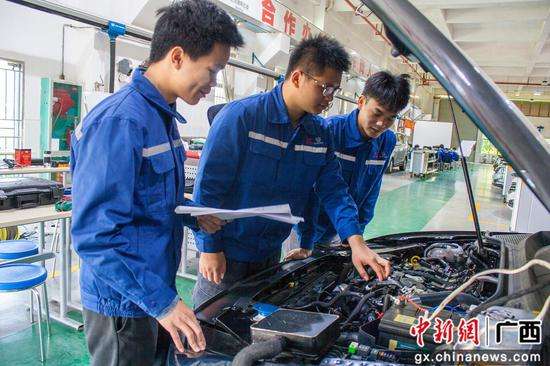(Peoples Daily Online)11:14, July 26, 2019![]()

Students in a vocational school in Guangxi check a car. (Photo/Chinanews.com)
“I’m so lucky to live in our time when skills are highly valued. I hope more underprivileged young people can change their fate through vocational skills like me,” said Ning Xianhai, who comes from a poor family in a mountain area of southwest China’s Sichuan province, and has won the First prize of the wielding event at the 44th WorldSkills Competition.
Ning is one of the many young Chinese people who have got rid of poverty through vocational skills they have learnt under the assistance of China’s Ministry of Human Resources and Social Security (MHRSS), which has carried out in-depth poverty-relief action in recent years.
“To train one more person and help the person obtain employment means to help one more family be better off through diligent work.” With this idea, MHRSS has teamed up with the State Council Leading Group Office of Poverty Alleviation and Development to roll out the campaign of offering free vocational education to students of registered poor households and free vocational training to people from poor families in over 1,000 vocational schools nationwide.
In 2018, a total of 2 million underprivileged people received relevant vocational training, while 64,200 students from registered poor households were enrolled in vocational schools across the country. In many vocational schools, the proportion of students from rural areas of the country exceeded 90 percent.
“We are endeavoring to promote technical education, so that the children of impoverished families can go to schools and learn skills that they can rely on for a better life in the future,” said Zhang Liyan, president of a technician school in northeast China’s Liaoning Province.
Dong Haoran, 19, is a sophomore in Fuxin Technician College in Liaoning Province. Two years ago, Dong chose the technician college over high school even though his test scores were good enough for a high school, since his family was in distress and he wanted to help relieve the economic burden.
Dong chose to study numerical control machining, which is a hot major in the manufacturing industry at present. Because of the favorable policy for impoverished students, Dong not only doesn’t need to pay the tuition and accommodation fee for the three-year college education, but also can receive a 2,000 Yuan (about $290.61) financial aid each semester.
Qi Bin, a 20-year-old man who graduated from a vocational school a year ago, now works as a numerical control machine tool operator and earns 6,000 Yuan a month.
“Many people of my age are still taking money from their family. But I’m now helping to reduce the economic pressure of my parents. And I’m also learning new things in my work every day. The field I work in has bright prospects,” said Qi, satisfied with his present life.
Qi is one of the many young Chinese people who secured good jobs after graduating from vocational schools. According to presidents of a lot of technician colleges in China, as long as the students are willing to work hard, they don’t need to worry about employment after graduation, as the situation of many majors is that demand for graduates exceeds supply.
Data from MHRSS has also shown that by the end of 2018, there were 2,379 vocational schools in China, which send about 1 million graduates into society every year, and the employment rate has always been above 97 percent.
Such an extraordinary employment rate is believed to be the result of the schools’ right decision on setting majors and the efforts they spend to talk with companies across the country, seeking opportunities for employment and internships of their students.
“We always do market research before we decide what majors should be set in our school,” said Qi Xin, vice president of Fuxin Technician College, explaining the school targeted market demand when setting majors, so that they can make sure the students have good prospects for employment.
Besides, Fuxin Technician College has also established a long-term cooperative relationship with many enterprises including Haier, Xuzhou Construction Machinery Group, and Liaoning Guangxia Group, which provide students with internships and opportunities to practice.
Not long ago, Zhang Liyan talked with eight companies in three days while she was on a business trip in east China’s Shandong Province, bringing back detailed information to students about recruitment needs, salaries, and conditions of these companies.
Such efforts are common in many vocational schools in China, as many try to expand employment channels for students and understand clear market needs so as to adjust school education accordingly.
